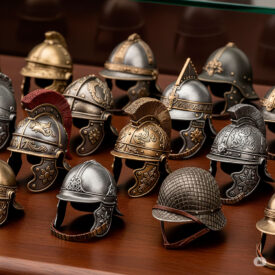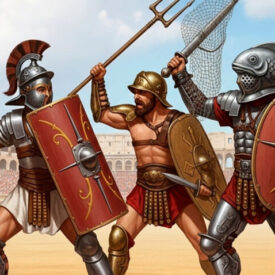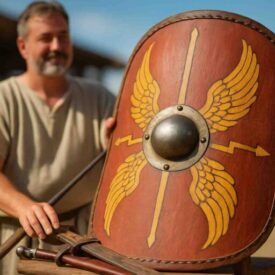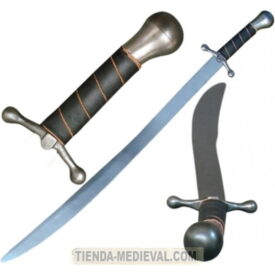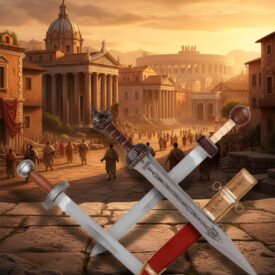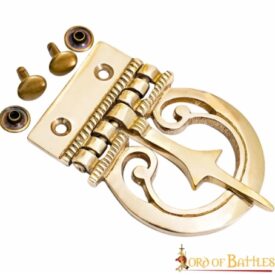From the wind-swept plains of Greece to the imposing borders of the Roman Empire, the shield was much more than a simple piece of equipment: it was the heart of war tactics, the sentinel of the warrior’s life, and the symbol of a civilization. But what secret lay behind those robust designs, the Greek Hoplon and the Roman Scutum? Which of them forged a path to victory with greater skill?
In this epic journey, we will unravel the mysteries of these two defensive pillars, analyzing their characteristics, the purpose they served, and how each one integrated into the psyche and strategy of their armies. Discover how wood, bronze, and human ingenuity shaped the tactical advantages that defined the course of ancient history.
The Strength of the Phalanx: The Greek Hoplon
The heart of the Greek hoplite beat to the rhythm of his Hoplon, also known as Aspis. This imposing round shield, often with a diameter close to a meter, was a masterpiece of collective defense. Made primarily of wood and covered with bronze, its weight of about 7 kg required a firm grip that went beyond a simple central handle: an innovative grip that rested on the shoulder, allowing the warrior to concentrate his strength on the thrust.
The true magic of the Hoplon was revealed in the phalanx formation. There, these shields intertwined, creating an impenetrable wall of bronze and wood. In the osthimos, the massive push of the phalanx, the Hoplon not only protected its bearer but also covered the exposed flank of the comrade to his left, transforming each man into part of an invincible war machine. Its disadvantage lay in the rigidity of this formation, which required flat terrain and was vulnerable to flanking maneuvers.
- Key Characteristics of the Greek Hoplon
-
- Shape and Size: Round and concave, approximately 90 – 100 cm in diameter.
- Weight: Around 7.25 kg.
- Materials: Wood and bronze.
- Grip: Double, solid fixation to the left arm and support on the shoulder/pauldrón for thrusting.
- Main Tactic: Phalanx formation and collective thrust (osthimos).
The Bulwark of the Legion: The Roman Scutum
 The Roman response to the challenges of the battlefield was the Scutum, a shield that evolved from oval to its iconic rectangular and curved shape. With a height of 1.2 m and a width of 0.8 m, this shield covered the legionary from shoulder to knees, offering unparalleled protection. Despite its size, its construction in layers of glued wood, reinforced with leather and metal, allowed it to weigh between 5 and 10 kg, being surprisingly light for its robustness.
The Roman response to the challenges of the battlefield was the Scutum, a shield that evolved from oval to its iconic rectangular and curved shape. With a height of 1.2 m and a width of 0.8 m, this shield covered the legionary from shoulder to knees, offering unparalleled protection. Despite its size, its construction in layers of glued wood, reinforced with leather and metal, allowed it to weigh between 5 and 10 kg, being surprisingly light for its robustness.
The Roman Scutum was the embodiment of tactical flexibility. It was wielded with a single central handle, allowing the legionary to use it actively, not only to defend himself but also to strike with its metallic umbo and unbalance the enemy. The Testudo formation, the Roman “turtle,” is a testament to its versatility, creating an almost impregnable barrier against projectiles. Its curved design facilitated the perfect fit of the shields, maintaining the cohesion of the formation. Roman legions, with their Scutum, were capable of maneuvering on any terrain, adapting from defense to attack with an agility that surpassed the rigidity of the phalanx.
- Key Characteristics of the Roman Scutum
-
- Shape and Size: Rectangular and curved, 1.2 m high by 0.8 m wide (classic shape).
- Weight: Generally between 5 and 10 kg.
- Materials: Layers of glued wood, leather, and metal reinforcements.
- Umbo: Central metallic boss for protection and attack.
- Grip: Horizontal central handle, facilitating active and offensive use.
- Main Tactic: Legion flexibility, close combat, and Testudo formation.
Shields and Tactics: Evolution from the Greek Hoplon to the Roman Scutum
The comparison between the Greek hoplon and the Roman scutum reflects technical and tactical transformations: the hoplon was conceived for the phalanx and collective thrust, while the scutum was developed for the legion and flexible, hand-to-hand combat. Below are the most relevant chronological milestones in their evolution and use.
| Era | Event |
|---|---|
| Archaic and Classical Greece | |
| Development of the Hoplon (aspis) | Round shield approximately 90–110 cm in diameter (c. 8th–4th century BC), weighing 6–7 kg, concave to rest on the shoulder and held on the left arm. Designed for the phalanx: overlapping among comrades, massive thrust (osthismos), and requiring flat terrain. |
| Monarchy and Early Republic of Rome | |
| Use of the Clipeus | The early Romans used the clipeus, a large, circular shield similar to the Greek aspis, suitable for closed formations and shock tactics inherited from the phalanx. |
| Republican Transition and Confrontation with Hellenistic Systems | |
| Emergence of the Republican Scutum (described by Polybius) | Oval and curved scutum (3rd–2nd century BC), constructed with glued planks and covered with linen/leather, with metal reinforcements and an iron umbo. It included a vertical protrusion (spina) in some early models. Its curvature and robustness already pointed to a more flexible combat system than the phalanx. |
| Tactics and comparison with the sarissa | Polybius observed that the scutum and the legionary system could counteract Macedonian sarissa formations; the legion favored maneuver, flexibility, and hand-to-hand combat over the frontal shock of the phalanx. |
| Classical Imperial Period | |
| Classic shape of the Scutum | The scutum adopted the semi-cylindrical rectangular shape (the “tile”), with a height of around 1.2 m and a width of ~0.8 m, covering from the shoulder to the knees. Usual weight between 7 and 10 kg (lighter variants documented ~5.5 kg). It was held by a central horizontal handle and featured a metallic umbo also used as an offensive weapon. |
| Tactical-operational integration | The scutum allowed flexible formations (cohorts), the use of the testudo as protection against projectiles, and interposition maneuvers to push and unbalance before employing the gladius. Its design facilitated the creation of a mobile and offensive “shield wall.” |
| Late Empire (from the 3rd century AD) | |
| Evolution towards oval or round shields | From the 3rd century AD, the rectangular scutum declined, and a repertoire of oval or round shields, lighter and more suitable for mobile infantry and more open formation tactics, was adopted. These later shields prioritized mobility and versatility over the classic shield wall. |
Clarifying doubts about Greek influence on Roman shields
How did Greek shields influence the design of Roman shields?
 Greek shields, especially the hoplite aspis, directly influenced early Roman designs during the monarchy and early republic, when Rome adopted combat tactics similar to the Greek phalanx. In this period, Roman soldiers carried round or oval shields, very similar to those used by Greek hoplites, as evidenced by artistic representations of the time.
Greek shields, especially the hoplite aspis, directly influenced early Roman designs during the monarchy and early republic, when Rome adopted combat tactics similar to the Greek phalanx. In this period, Roman soldiers carried round or oval shields, very similar to those used by Greek hoplites, as evidenced by artistic representations of the time.
As Rome militarily evolved, the most characteristic Roman shield, the scutum, took on a rectangular and curved shape, clearly differentiating itself from the Greek model. However, the basic idea of a large shield that covered a good part of the soldier’s body and was used in a closed formation is a heritage of the hoplite concept, although adapted to the tactical and organizational needs of the Roman army. Therefore, Greek influence was decisive in the genesis of the Roman shield, but then it evolved autonomously according to the demands of Roman warfare and expansion.
What war tactics were more effective with the Roman Scutum compared to the Greek Hoplon?
Tactical Comparison: Roman Scutum vs. Greek Hoplon
The Roman Scutum and the Greek Hoplon were fundamental shields in the infantry of their respective cultures, but their design conditioned very different tactics on the battlefield.
Roman Scutum: Flexibility and Mobility
- More open and modular formation: The Roman scutum, large, oval, and slightly convex, allowed legionaries to fight in more flexible and less compact formations than the Greek phalanx. Romans could operate in independent units (maniples or cohorts), change front quickly, and adapt to irregular terrain.
- Line rotation and flanking: The mobility of the scutum facilitated the rotation of combat lines and the relief of tired troops, as well as allowing flanking and encirclement maneuvers thanks to less dependence on absolute frontal cohesion.
- Hand-to-hand combat: The scutum was combined with the gladius (short sword), ideal for close combat after the impact of the pilum (throwing spear), which disorganized enemy ranks before the clash.
- Individual and collective defense: Although it protected the bearer well, the scutum was not intended to cover the comrade next to it as much as the hoplon, which made maintaining a closed formation less critical and allowed for greater individual initiative.
Greek Hoplon: Cohesion and Frontal Strength
- Closed and rigid formation: The hoplon, round, convex, and with a double grip, was designed for the phalanx: a compact formation of several rows where each shield protected the soldier and partially the one to his left. This required maintaining perfect alignment and advancing as a single block.
- Coordinated frontal thrust: The main tactic was synchronized advance and thrust (othismos) against the enemy, taking advantage of the collective weight and the length of the spears (dory) from the first ranks.
- Defense on flat terrain: The phalanx was very effective on open, flat terrain, where it could maintain cohesion, but vulnerable on uneven terrain or to flanking maneuvers.
- Prolonged combat: If the formation broke, the hoplon and short sword (xiphos) allowed for defense, but maximum effectiveness was achieved only in a closed formation.
Summary of Tactical Advantages
| Shield | Most Effective Tactics | Main Limitations |
|---|---|---|
| Scutum | Flexibility, mobility, line rotation, flanking, hand-to-hand combat, adaptation to varied terrain | Less lateral protection for the comrade, less effective in massive frontal shock |
| Hoplon | Cohesion, frontal thrust, block defense, superiority on flat terrain | Rigidity, vulnerability to flanking and irregular terrain, extreme dependence on formation |
The Roman scutum allowed for more flexible, mobile, and adaptive tactics, ideal for varied terrain and dynamic combats where flanking and troop rotation were key. The Greek hoplon, on the other hand, favored brute frontal force and cohesion in a block, being almost unbeatable on flat terrain as long as the formation was maintained, but very vulnerable if it broke or the enemy attacked from the flanks.
Differences in Mobility
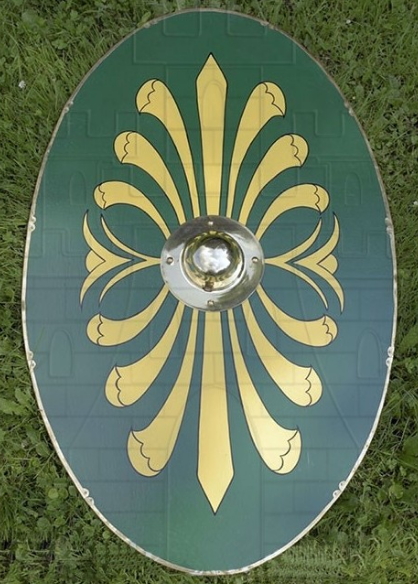 What differences in mobility and protection did Greek and Roman shields offer?
What differences in mobility and protection did Greek and Roman shields offer?
- Greek shield (hoplon/clipeus): It was round and large, but its design allowed it to be held with a central grip, which gave greater freedom of movement to the arm. This facilitated more dynamic tactics, such as charging and pushing (othismos), and allowed hoplites to move with relative agility in the phalanx, although the weight (around 7 kg) could limit its prolonged use in rapid maneuvers.
- Roman shield (scutum): Rectangular or semi-oval in shape, it was even larger (covering from shoulder to knee) and concave, which made it less maneuverable individually. However, its design was intended for compact formation and collective defense, especially in the turtle formation, where individual mobility was sacrificed in favor of group protection and coordinated advance.
Differences in Protection
- Greek shield: Its round and convex shape protected the torso and part of the legs well, but left gaps between soldiers in formation, exposing flanks. The central grip allowed it to be used for pushing, but it did not completely cover the body from projectiles or lateral blows.
- Roman shield: Its large rectangular size and lateral curvature provided almost total coverage of the legionary’s body, effectively protecting him from arrows, javelins, and frontal and lateral blows. The curved design helped deflect impacts, and the central umbo reinforced defense against thrusts. In addition, the scutum allowed for forming an almost continuous barrier in the testudo, offering superior group defense against projectiles and frontal attacks.
Key Points Greek vs. Roman Shields
- Greek shields offered better individual mobility and were ideal for pushing tactics and close combat in open formations.
- Roman shields sacrificed individual mobility for almost complete body protection and superior group defense, key for compact legion tactics and defense against projectiles.
How did Roman shields evolve throughout Rome’s different eras?
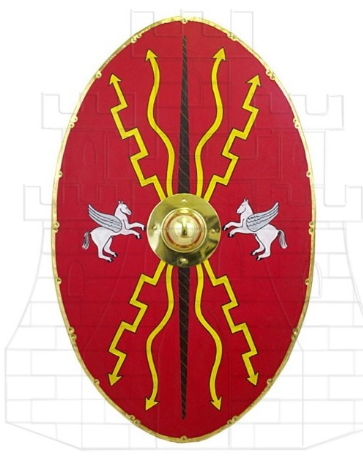 Throughout Rome’s history, military shields evolved remarkably, adapting to the tactical and strategic changes of the Roman army.
Throughout Rome’s history, military shields evolved remarkably, adapting to the tactical and strategic changes of the Roman army.
Monarchical Period (8th–6th centuries BC)
- The first shields, used in the time of the monarchy and Etruscan influence, were round (clipeus), similar to those of Greek hoplites, and were made of wood and bronze.
- These shields were suitable for individual and poorly organized combat, typical of Rome’s early military structures.
Republican Period (5th–1st centuries BC)
- With the adoption of the phalanx and, later, the manipulated legion, the oval, curved, and larger scutum emerged, which allowed better protection for the soldier and facilitated closed-formation combat.
- The Republican scutum was made with glued wood planks, reinforced with linen, leather, and metal edges, achieving a balance between strength, lightness, and protection.
- The morphology of the shield remained quite stable for most of the Republic, as it was effective for the tactics of the time.
Imperial Period (1st century BC–5th century AD)
- At the beginning of the Empire, the scutum evolved into a rectangular shape, with rounded edges and a pronounced curvature, which improved protection in formations such as the “testudo.”
- The shield became lighter (around 5.5 kg), with metal reinforcements at the corners and a thicker center for greater resistance.
- Identification elements, such as the legion number, were incorporated, and the umbo (central metallic boss) remained key for both defense and attack.
- In the late Empire, facing crisis and the professionalization of the army, a return to simpler and lighter, oval or circular shields was made, more similar to those used by barbarian peoples.
Roman Shields you can buy online
The evolution of Roman shields reflects the army’s adaptation to new forms of combat and organization. From the round clipeus of the monarchy, through the large oval and curved shields of the Republic, to the rectangular, reinforced, and personalized scutum of the Empire, each change was linked to tactical, material, and military identity needs.
What impact did the adoption of Greek elements have on Roman military equipment?
The adoption of Greek elements in Roman military equipment had a significant impact by transforming the organization and armament of Rome, contributing to the evolution of its army towards a more effective and flexible system. Initially, the Roman army incorporated the Greek hoplite panoply, adopting the armament and phalanx formation that allowed cohesion and discipline in combat. This influence was key in structuring the army through social and military reforms, such as that of Servius Tullius, who divided soldiers into classes based on their economic capacity to afford Greek equipment, especially heavy infantry organized into centuries.
However, Rome did not limit itself to copying the Greek phalanx but developed the legion, which emphasized greater tactical flexibility, mobility, and adaptability on the battlefield, overcoming the limitations of phalangist rigidity. This allowed Rome to conquer and maintain a vast empire, as its military system was more dynamic and capable of facing different types of enemies in diverse contexts.
In summary, the incorporation of Greek elements provided the Roman army with effective initial equipment and formation, which served as a basis for subsequent perfection and adaptation, making the Roman legion a superior war machine central to its imperial expansion.

